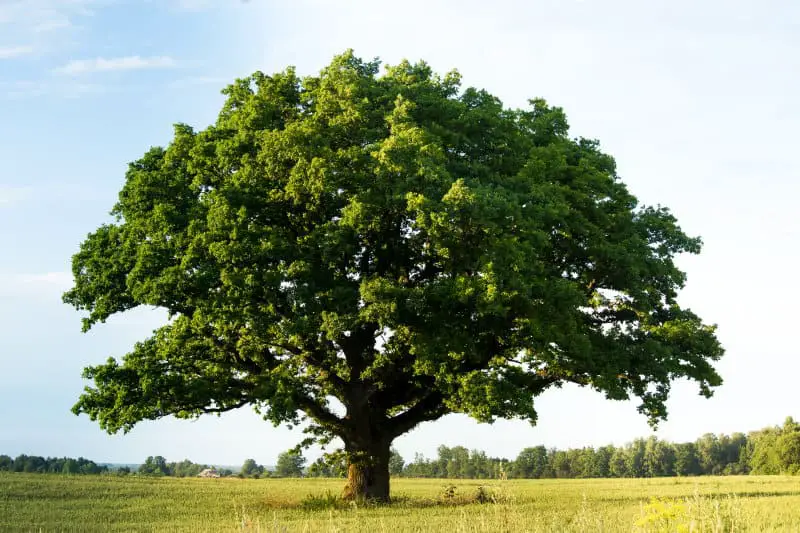The growing concern of EMF radiation has left many people wondering how to protect themselves against its dangers. With so many EMF protective products on the market, you may be wondering whether trees can block EMF.
Here’s what I have found out.
Trees do not block EMF waves but can reduce the amount of radiation exposure. The tree’s trunk and leaves will dissipate signal strength as the high-frequency EMF waves pass through the tree. In this way, the tree will act as an obstruction and dampen the signals. If you plant trees around your home, you can reduce exposure to EMF radiation from power lines and cell towers.
However, trees alone will not shield you from all EMF sources around you. This article will discuss how trees obstruct signal strength, how much radiation they block, and what types of trees to plant.
How do trees reduce EMF radiation?
Since the level of exposure weakens as the radiation passes through an object, tree trunks and leaves act as a shield, reducing the impact of EMF radiation around your home—they do this by causing a gradual loss in force as the radiation passes through the trees.

Like other protective materials that block EMFs, trees reduce wireless RF radiation and electric fields emitted by overhead power lines. The water content in the trees attenuates higher frequency signals as they pass through the tree trunk.
Although there are complaints that trees block internet signals, they can lower your risk of exposure. The National Institute for Standards and Technology (NIST) conducted a study to find out how trees impact wireless signals. The test included wood with a thickness of 15cm.
To optimize EMF-protective materials like trees and wood, you must first establish their effectiveness. The distance between the radiation source and your residence also affects EMF exposure.
Other protection materials such as aluminum, copper, and mylar attenuate EMF by scattering photons as they pass through the material. Read my detailed article on EMF protective materials to know other alternative ways to reduce EMF signals from powerlines penetrating your walls and windows.
Radiation from power lines and cell towers
Overhead power lines and cell towers create high-frequency electromagnetic fields. The strength of these EMFs depends on how far you are from them. So, increasing your distance between the sources of EMF will lower your exposure level.
According to a World Health Organization (WHO) study, EMF and RF signals present various physical ailments to those who live near the lines. Subsequent research links childhood leukemia and certain types of cancer to EMF radiation from power lines and cell towers.
Above or below ground, high-voltage electrical currents are transmitted through power lines (under your feet). Radiation from power wires is more damaging to your health than radiation from portable devices like your mobile phone since it is not under your direct control, although it helps to keep your phone at a distance for a while.
But you can’t possibly do that with the power line if you live near them, right? If this is true for you, review this article to learn how safe it is to live near power lines, which lines emit EMF radiation, the specific dangers of EMF radiated by these power lines, and most importantly, steps you can take to stay safe.
How much EMF radiation do trees reduce?
Trees may help reduce both high and low EMF levels in your house. Some trees are more efficient than others. Hence, you must compare each tree’s EMF radiation absorption levels, which depends on the tree’s thickness and density. The thicker and denser, the better. Concerns about wireless control systems working in a dense setting have led many to wonder whether wood can genuinely block EMFs.
So, wood blocks EMF radiation?
No, wood does not block EMF radiation. Like EMF shielding materials, wood reduces the quantity of radiation passing through it.
Fresher wood has more water content and better shielding characteristics than dry wood. So, thick wood may reduce high-frequency EMF emissions.
You can measure the material’s ability to attenuate the signals in decibels (dB).
Also, check out my tips on how to reduce EMF radiation exposure.
Types of trees that reduce radiation
Various types of trees absorb and reduce electromagnetic exposure around your home. Both electric and magnetic fields emitted by power lines and other wireless frequencies cause many of today’s health risks.
Exposure to the long-term effects of EMFs has an impact on your health. You can read Non-Tinfoil Guide to EMFs to learn about EMF radiation and its effects.
If you’re concerned about EMF exposure and the potential risks to your health, you should consider planting these types of trees. They reduce not only your radiation exposure levels but also control humidity, temperature, and wind.
1. Pine trees
A pine tree is a coniferous tree that absorbs radiation and beautifies your home. The evergreen plant has high leaf density and is alive all year round, making it the best tree for EMF radiation control. The tree’s structure and canopy contribute to the performance of the tree.
More layers of leaves make the tree more efficient in reducing high-frequency wireless signals in the surrounding environment.
Pine trees grow well in an open area with a high circulation of air and sunlight.
2. Cherry tree
Cherry is another EMF protection plant that absorbs radiation emitted in the environment. It is a deciduous tree with flowers that bloom in summer. This type of plant reduces radiation and controls air temperature, wind, and humidity.
Plant cherry trees in an area with good air circulation. You can plant it indoors and outdoors as long as there is plenty of sunlight. For the plant to reach its full potential, you have to irrigate it regularly.
3. Oak tree
An oak tree is a deciduous type of tree that grows in most parts of the world. Although this tree doesn’t provide all-year-round protection, the spread-out branches with broad flat leaves attenuate radiation as it passes through. They provide an excellent shield against EMFs during the summer and spring months and lose their leaves during the winter months.
Conclusion
The growing concern about the effects of EMF radiation has forced us to look for ways to protect ourselves. If you’re wondering which is the best way to protect yourself, look at my detailed article on ways to protect yourself from different types of radiation.
Furthermore, you can plant trees between your home and radiation sources to reduce the risk of exposure. You can also grow indoor plants to strengthen your protection, which we discuss here.





